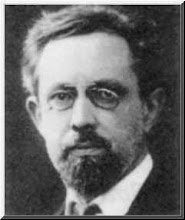Clarence Henry Rook's Hooligan Nights (1899) purports to be a piece of late Victorian London underworld reportage. It is not clear that it is anything of the sort and certainly the contemporary reviewers were sceptical. Rook tells us that it is not a work of fiction and that Young Alf his informant was introduced to him by Grant Richards the bohemian publisher. There is an episode in one of Richards' autobiographical volumes that seems to confirm this, though perhaps the fit is too good, for it is more or less a precis of one of the chapters in Rook's book. Benny Green in the introduction to the OUP edition points out a number of similarities between some of the stories that Rook relates and possible fictional sources.
Rook certainly wrote some detective fiction and was very familiar with the stories of Arthur Morrison having published a literary essay about him in 1897 in an America periodical. He also places some of the principal characters of The Hooligan Nights - Young Alf, Maggots, Annie (Alice?) in a 1900 Paul Mall Magazine story called "The Stakes" which is clearly a work of fiction. The sheer implausibility of "Young Alf" and Rook striking up a friendship as well as the Tales of Mean Streets episodic structure make me smell a rat.
Green suggests that Rook was something of a man of mystery who had disappeared from the literary landscape without leaving many traces. Some disinformation has been published about him, for example Bill Schwarz writing in Modern Times: Reflections on a Century of English Modernism, Nava and O'Shea (eds.) manages to persuade himself that Rook was an American, which he wasn't. But if one looks hard enough it is not too difficult to find some basic facts about a relatively short literary life.
He was born in 1862 or 1863 in Faversham, Kent, the only son of Henry John Rook who is recorded in the 1871 and 1881 census as a Bookseller and Post Master. The family lived above the shop at 2 Market Place but seemed to be moderately prosperous and employed 2 servants. That the family had some cash is confirmed by the fact that in 1881 Rook matriculated at Oxford (Oriel) and graduated in 1886. According to the obituary notice printed in the Guardian he also spent time in Leipzig and Bonn, which probably account for the length of time it took him to graduate. The obituary also confirms what can be inferred from the 1891 census where he is to be found in Bristol working as an army and civil service examination tutor ie he was a crammer.
In September 1893 he married Clara Wright, the daughter of an artistic decorator, and gives his profession on the marriage certificate as journalist. He is known to have worked with E.V. Lucas at the Globe and with Nevinson at the Daily Chronicle where he founded the "Office Window" column. The Punch connection is underlined by a poem penned by its editor Owen Seaman for the edition of January, 6th, 1909. It is titled 'A Guide to Popular Emotion' and is a satirical comment on the view expressed in the "Office Window" column about the balance in newspaper reporting between tragic events taking place overseas and trivial domestic news. Whether this is a direct comment on Rook is unknown.
What we do know is that Rook was a prolific and probably rather successful journalist. As well as writing for the Globe and the Chronicle he published in The Illustrated London News, The Idler, The Ludgate, The Art Journal and various American publications. He seems to have been well thought of - Bernard Shaw - praised him to the skies - and well connected. Louis Frederic Austin was a personal friend and between 1895 and 1898 Rook was a member of the Argonaut's Club which seems to have been a literary dining society meeting at the Trocadero. Other members were Rudolph Lehman (another Punch connection - there is also a rather tenuous sociology connection there but I'll leave that for another time), Florence Marryat (prolific popular novelist and daughter of Frederick), Bernard Partridge (cartoonist and another Punch connection), John Alfred Spender (editor of the Westminster Gazette), George Paston (the novelist Emily Symonds), Ethel Tweedie (another author), William Henry Wilkins (a novelist) and Alice M. Williams (probably a popular songwriter). Of these the most important connection was probably with Rudi Lehman who knew everyone on the middle-brow London literary and journalistic scene and was elected to Parliament in the 1906 Liberal landslide.
In August 1904 Rook is to be found (without his wife) on the passenger list of the Grosser Kurfurst sailing from Southampton to New York. This also tells us that he was an English national, that it was his first time in the USA and that his onward destination was St Louis. In fact he writes about the trip in a 1906 piece called "American Manners". In 1909 he again sailed alone, this time on the Chama, first class from Liverpool to Grand Canary.
Throughout his married life Rook lived at some fairly swanky addresses in Chelsea and on the outskirts of Belgravia indicating that he did rather well out of his journalism. On his death in 1915 he left his widow £1300 which was a tidy enough sum. Green in his introduction to The Hooligan Nights points out that Rook's death certificate contains the information that for 26 years he had suffered from Locomoter Ataxy, a symptom of tertiary syphilis. Perhaps he knew even more about London's low-life than he was letting on.









2 comments:
Yes - because only the poor contract syphilis, right?
Not really.
Post a Comment